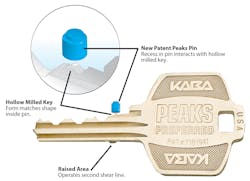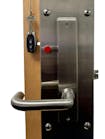High Security locks are one line of products which every locksmith should be actively selling. The question is not if you are selling High Security but rather which brand you are selling and what is your reasoning for selling products from that particular company.
Before deciding on which High Security product line to sell, ask your distributor questions such as:
- How hard is it to rekey?
- Can keys be duplicated on a standard duplicating machine?
- Are cylinders and key blanks stocked by your favorite distributor?
- How long is the patent protection life?
- Is there a strong key control policy?
- How much inventory must be initially purchased?
- Are cylinders available for retrofitting most existing mortise lock, cylindrical lock and interchangeable core applications?
- Is this product made in USA?
If your locksmith distributor can provide favorable answers to the questions above for the High Security product line you are considering, then you can sell that High Security product confident that it will meet most, if not all, of your customer requirements. Kaba Peaks, the topic of this article, is a High Security product line which meets or exceeds this line of questions.
Peaks patented key control is provided by a novel mechanical feature located near the key bow on both the top and bottom of the key blade. Projections on Peaks key blanks differentiate Peaks from standard key blanks. These projections are the critical mechanical requirement for a utility patent to protect against unauthorized key duplication. Since the uncut key itself is patented, Kaba controls both manufacture and distribution of key blanks. All Peaks key blanks are also marked with a unique identification number for further key control purposes.
Projections on the Peaks key blank are designed to lift a secondary pin to the shearline before the plug can be turned. The secondary pin is not part of the regular key combination.
Peaks was originally named Classic and the bottom of the secondary pin was rounded to interact with the projection on the key blank. Classic Peaks patents have been replaced by a new patent called Preferred. The Preferred secondary pin has an internal, cone-shaped working end. Precisely shaped projections on Peaks Preferred key blanks are designed to fit into the cone shaped end and lift the secondary pin to the shearline.
Are Peaks cylinders available for retrofitting most locks?
Kaba Peaks is a combination of conventional mortise, rim, key-in-knob and interchangeable core lock cylinders which can all be operated by the same patent protected key system. In addition to a complete line of small format interchangeable core cylinders (SFIC) , Kaba Peaks Preferred cylinders are also available to retrofit large format interchangeable core (LFIC) cylinders such as Corbin-Russwin, Yale, Schlage and Sargent locks. Kaba Peaks Preferred products are made in USA.
Must Kaba Peaks keys be cut on special key machines?
Kaba Peak projections are factory precut. All regular key combinations require a cutter angle of 90 degrees and a cutter flat of .046". This cutter shape is identical to dimensions used for originating standard SFIC keys. According to Kaba Peaks literature, most Peaks keyways are paracentric and are not designed to be clipped using a key bitting punch. Kaba Peaks keys can be originated on industry-standard key machines such as Framon, HPC, ITL and the Ilco Universal. Jaws on some older originating and duplicating machines may interfere with the projection on the bottom of a Kaba Peaks key blank. Either key machines in the field can be modified to accept the Peaks projection or modified jaws may be available. Consult Kaba for definitive requirements.
Kaba Peaks key blanks contain both a shoulder stop and a tip stop. Keys can be gauged from either location when duplicating or originating keys. Tolerances are tighter than most other brands. Depth and spacing must be held within +/- .002. To originate keys on code machines which use a rack-and-pinion system, Kaba suggests key origination by beginning cutting procedures at the tip and proceeding back to the key bow.
Are there special rekeying procedures?
Peaks pinning is based on industry-standard A2 and A4 keying systems. Cylinder pinning is accomplished by top loading. Depending on the specific Peaks lock cylinder being serviced, pin holes are covered by using either a single spring cover or individual caps.
Cylinder pin length dimensions are not the same exact length as standard SFIC pins tumblers. Bottom pins are nickel silver. Spool pins are used to increase pick and impression resistance. The Kaba Preferred service manual states, "Non-original pins will not work properly in Kaba products and their use voids product warranty."
Two different cut-to-cut spacing systems are used: .140" or .150". .150" cut-to-cut spacing can only be used when all locks in the key system require SFIC cylinders. When a key system includes any combination of mortise, rim, key-in-knob, SFIC or LFIC cylinders then .140 cut-to-cut pin spacing must be used.
Plug diameters and cylinder housing sizes can vary depending on which Peaks lock cylinder is being serviced. Conventional SFIC cylinders must be small to fit into figure "8" housings. Plugs and housings for mortise, rim and key-in-knob cylinders are larger than SFIC cylinders. Dimensions of Peaks cylinders for retrofitting various LFIC cylinders can vary depending on original manufacturer dimensioning.
Explanation of pin stack mathematics is outside the scope of this article. However, the normal pin stack total for SFIC A2 systems is 23 and for SFIC A4 systems is 14. Pin stacks for Peaks Preferred and Classic SFIC cylinders are identical to traditional SFIC standards, regardless of the cut-to-cut spacing be used. If you are familiar with traditional SFIC pin stack standards, no new mathematics is required. Because plug diameters and housing sizes can vary when servicing any other Peaks product besides SFIC cylinders, bottom pin lengths and pin stacks can also vary. Peaks pin stack mathematics are not hard to learn. Follow instructions in the Peaks manual for exact pinning methods.
How to become a Kaba Peaks Preferred dealer
Contact your local Kaba locksmith distributor or call Kaba Key Systems at: 800-849-8324 x285. To ensure key control, each Kaba Preferred Locksmith dealer has their own unique ID number stamped on all of the key blanks they receive. As stated in the Kaba Peaks Preferred manual, "Peaks Preferred is the most cost effective, application flexible, patent end-user key control system available."
Patents & Expiration Dates
- Abloy Protec 2: 2031
- Medeco KeyMark X4: 2027
- Peaks Preferred: 2024
- Schlage Primus XP: 2024
- Kaba Peaks Global: 2023
- Assa Cliq: 2021
- Medeco M3: 2021
- Abloy Protec: 2019
- Kaba L10: 2017
- Corbin Pyramid: 2017
- Assa Twin Pro: 2015
- Schlage Everest Primus: 2014
- Arrow Flex Core: 2012
- Sargent Signature: 2012
- Kaba Gemini T: 2012
- Medeco KeyMark: 2011
- Kaba Peaks Classic: 2010
- Assa Twin V10: 2008
- Kaba Gemini: 2006
- Schlage Primus: 2005
- Medeco Biaxial: 2004
- Assa Twin 6000 blank (design patent): 2000
- Abloy DiskLock Pro: 1999
- Medeco Original: 1987
- Distributor “Locksmith” Keyways: no patent
- Commonly called “Restricted” Keyways: no patent






